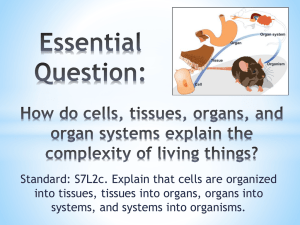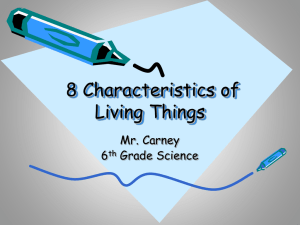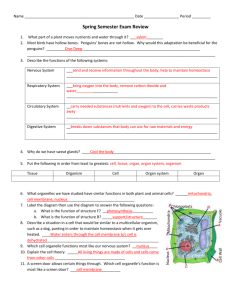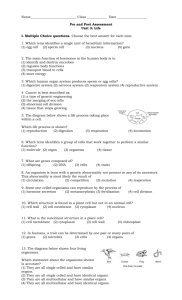nucleus
advertisement
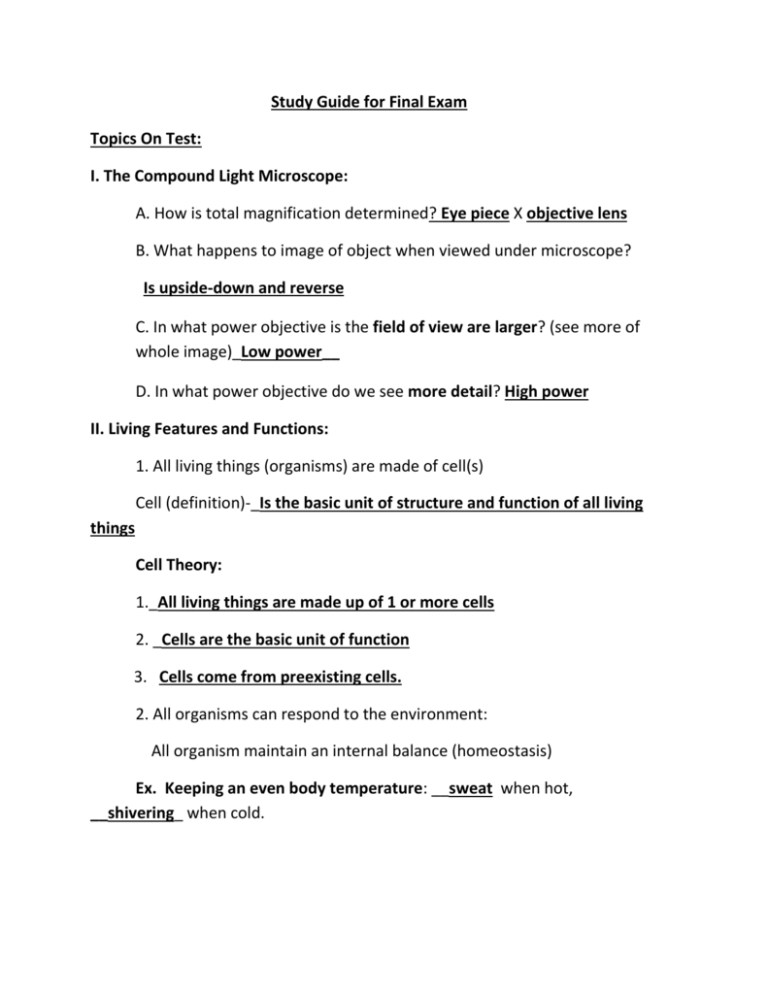
Study Guide for Final Exam Topics On Test: I. The Compound Light Microscope: A. How is total magnification determined? Eye piece X objective lens B. What happens to image of object when viewed under microscope? Is upside-down and reverse C. In what power objective is the field of view are larger? (see more of whole image)_Low power__ D. In what power objective do we see more detail? High power II. Living Features and Functions: 1. All living things (organisms) are made of cell(s) Cell (definition)-_Is the basic unit of structure and function of all living things Cell Theory: 1._All living things are made up of 1 or more cells 2. _Cells are the basic unit of function 3. Cells come from preexisting cells. 2. All organisms can respond to the environment: All organism maintain an internal balance (homeostasis) Ex. Keeping an even body temperature: __sweat when hot, __shivering_ when cold. 3. All organisms do similar functions: Metabolism- The sum of all chemical reactions within an organism (building, breaking down, storing and using energy) Examples of metabolic activities in organisms: Digestion: breaking down food into nutrients Excretion-_getting rid of metabolic waste_ 4. All organisms need Energy. A. All energy for life on earth comes indirectly or directly from the _SUN_ B. Energy is passed from organism to organism along a FOOD CHAIN C. Overlapping food chains in a community is represented as a __FOOD WEB__. D. Identify an autotrophic organism in the diagram to right__ANY PLANT. E. Identify a heterotrophic organism in the diagram to the right_ANY ANIMAL. F. The diagram below shows how much energy is available at each level in a food chain or web is called an __ENERGY PYRAMID. G. As you read up the pyramid, the amount of energy available at each level ___DECREASES_ H. Know definitions and give examples of: 1. autotroph (producer)- Organism that makes its own food 2. heterotroph (consumer)-Organism that get energy from otherorganisms 3. decomposer—_Organism that breaksdown dead organisms and returns nutrients to the environment 5. All living Things Can Make More of Themselves (Reproduction) A. Asexual Reproduction- the production of offspring from _One_ parent. Offspring are _100_% genetically identical to parent. Examples: Hydra _Budding Paramecium-__Binary fission (Type of asexual reproduction) (Type of asexual reproduction) B. Sexual Reproduction- the production of offspring from _two parents. (cells) Offspring receive _50_% of its genetics from each gamete (sex cell) sperm Egg Fertilization III. The Cell 1. Organisms are either unicelled __One cell_____ or multicelled__many cells______. 2. Organisms that are multi-celled have cells with specific jobs: Ex. Red blood cell_Carry Oxygen_, leaf cell Performs photosynthesis 2. Cells without a nucleus are called _Prokaryotic. Cells with a nucleus are_Eukariotic. 3. Plant an Animal cell diagrams. Identify the plant or animal cell. _Animal cell _Plant__cell Match the number pointing to the organelle with its proper function: _3___ control center of cell (contains chromosomes) (name:_nucleus) _2___stores materials (name: Vacuole) _4___ filler of cell (circulates, chemical reactions occur here) (name:_cytoplasm) _5___supports, nonliving outer layer(name:_cell wall__) __6__photosynthesis (name:_Chloroplast_) __1__controls what goes in and out of cell (name:_cell membrane_) IV. Cell Processes: 1. Photosynthesis: process of making_food (glucose)_ using the sun’s energy 6 H2O + 6CO2 + light Energy C6H12O6 + 6O2 Performed by _Chloroplast_(ex. _plants_, _algae_, some protists) 2. Respiration: process of getting ENERGY out of food by adding _Oxygen_ C6H12O6 + 6O2 ATP energy + 6H2O + 6CO2 3. Cell Reproduction: a. Mitosis – cell production making _Somatic cells (diploid)(body cells) b. Meiosis- cell production making gametes(haploid) (sex cells-egg and sperm) c. Which type of cell contains the full amount of hereditary material? somatic cells diploid d. Which type of cell contains one half the hereditary material? _gametes (haploid) 4. Passive and Active Transport: how substances enter and leave a cell through the cell membrane. a. Passive transport- no energy, molecules move by Difussion (from a region of _high_ concentration to a region of _low_concentration) b. Active transport- uses energy V. Classification: 1. What is the order of the groups of the classification system (from largest to smallest): Kingdom, Phylum, Class, Order, Family, Genus, Species 2. Organisms in the same species are able to reproduce and produce fertile offspring. 3. What 2 groups (levels of classification) make up the scientific name of an organism? Genus Species example: Canis lupis VI. Genetics/DNA 1. Genes are found on strands of DNA called Chromosomes which are located in the nucleus of cells. 2. Define genotype and phenotype. Fill in the information below using the trait for height in pea plants with alleles: T = tall t = short A. genotype: (definition)_Genetic makeup (alleles) B. phenotype (definition)_Physical traits characteristics Phenotype Genotype Homozygous tall _TT_ Homozygous short _tt__ Heterozygous Tall _Tt__ C. Be able to do a Punnett Square from a given cross to determine possible genotypes and phenotypes in offspring. Ex. In a guinea pig, black fur (B) is dominant over gray fur(b). In the Punnett Square below, show a cross between 2 hybrid guinea pigs. Determine the probability based on the Punnett square information: _75_% black __25_% gray B B b BB Bb _25_% homozygous black _25_% homozygous gray b Bb bb 3. Hereditary Material (_DNA_= deoxyribonucleic acid) a. Makes up _CHROMOSOMES__ in nucleus b. Fill in the complimentary DNA strand below: A-___T T-___A T-___A C-___G G-___C A-___T 4. karyotype- a diagram showing homologous chromosomes of an individual. It is used to determine gender and chromosomal disorders. Gender= ___Female___ Gender= _____Male_ VII . Human Systems 1. Levels of Organization in the Human Body (simplest to complex) Cell Tissue Organ Organ system organism 2. Know basic function(s) of major body systems and their parts (organs): Use the provided description key and word bank to complete the missing information below: A. Circulatory System: 1.Function- _Transport (moves) materials.__ 2. Parts: _HEART_=muscular organ that pumps blood about body _ARTERY_= blood vessels that carry blood away from heart VEINS_ = blood vessels that carry blood towards the heart CAPILLARY_ = small blood vessels where gas exchange occur PLASMA_= liquid part of blood RED BLOOD CELLS_= blood cells that carry oxygen WHITE BLOOD CELLS = blood cells that fights infection PLATELETS_= blood cell parts that aid in clotting B. Digestive System: 1. Function: break-down of _FOOD_ and absorption of digested nutrients into _BLOOD_. (Through the villi. Small intestine) 2. Parts (Organs): Label the organs in the diagram below: mouth a. In which organ does digestion begin? Mouth esophagus b. In which organ does digestion end?_Small Intestine__ liver stomach Pancreas C. Respiratory System L. intestine S. Intestine 1. Function:_Bring oxygen into the body (blood)___ 2. Parts: List the order in which oxygen enters the body. Nose- _pharynx, trachea, bronchi_, _bronchioles, alveoli (lungs) 3. In which part does the oxygen enter the bloodstream and carbon dioxide exit the bloodstream? alveoli D. Excretory System (Urinary System) 1. Function: filtration of cellular _waste_ from __blood__. kidney 2. Parts : Label the organs below. 3. What is organ (X) that accomplishes the task of filtration? _kidney_ ureter bladder urethra E. Nervous System 1. Function: controls body using electrical_messages. 2. Parts of the brain and their functions: A. Cerebrum B Cerebellum C medulla 3. Describe the function(s) of each part: A. _controls voluntary movement, learning, etc.._ B. _coordinates balance_ C. _Involuntary movements__ F. Endocrine System 1. Function: control the body with chemicals called hormones. 2. Organs of the Endocrine System are called _glands_. 3. Study the diagram below: G. Muscular System: 1. Function:_Movement_ 2. Label the structures of the arm: A. tendon B. muscle C. ligament D. bone H. Skeletal System 1. Identify the 5 functions of the skeletal system a. protects _internal organs__ b. attachment to muscles for motion/movement c. stores _calcium_ & _phosphorus_ d. provides _shape__ & _support___ e. bone marrow makes _blood cells I. Reproductive System 1. Function(s): a. Produces gametes (_sperm)male and (_egg__)female b. Allows for continuation of species by producing offspring_



